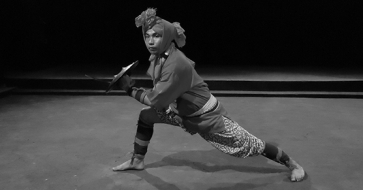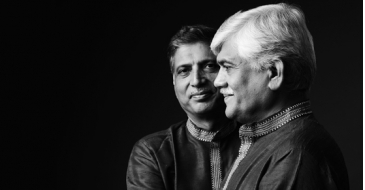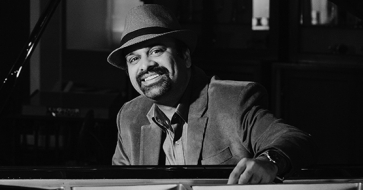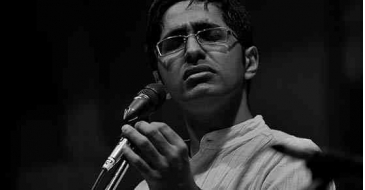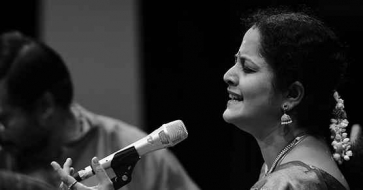Okay let's start with the basics; what, according to you, is art?
Well, art is a construction by humans for humans to become aware of themselves. It is a celebration of the human mind, a marvel that we conceived of and created so many different ways of reflecting, of tapping into the abstract within and thereby deepening our awareness of ourselves. Art offers both the artist and the audience a window into humaneness.
That's fascinating! What then is the purpose of art?
Transformation. The experience of art is capable of great transformations. For me, transformation begins with the individual. You can't have conversations about the larger society without investigating the self. Some people do this consciously. Some others organically. Some articulate it. Some don't.
Do all art forms intend to transform?
Well, every art form does not have the same intent. The human mind figured out – early on - that we need different triggers or stimuli, each moving us in varied ways, using distinct aesthetic structures.
What about Carnatic music; what is its intent?
I'd say abstraction. Carnatic music uses raga (melody), tala (rhythm) and sahitya/vak (text - linguistic and non-linguistic) to abstract life experiences. It is not about your life or my life but about the experience of life.
Carnatic to me is not devotional or religious music. If you derive religiosity from listening or performing it, it is something you are personally doing, conditioned by your environment. It is incorrect to impose that on the intent of the art form itself. I make this observation from a study of the form, its history and practice. The greatest composers including Tyagaraja, Muthuswami Dikshitar and Syama Sastri soaked in this quality.
I also see Carnatic music as a possibility for human interaction and exchange. Within its form there are so many gifts that make it dynamic and free, if only we are willing to change our position or perspective.
Transformation. The experience of art is capable of great transformations. For me, transformation begins with the individual. You can't have conversations about the larger society without investigating the self. Some people do this consciously. Some others organically. Some articulate it. Some don't
Okay, but could you break down how you use the word abstraction itself?
The literal is always connected to an event, an occurrence or multiple happenings. The abstract is the experiential essence of the event or happening. For example, "You had lunch at my house today" is literal. The experience of eating is abstract.
The literal happenings of our life are all emotional experiences. Carnatic music hopes to capture that essence. Therefore a sublime experience in Carnatic music is an intensely impersonal profound moment.
Can you give an example?
When I sing a raga alapana or a kriti, many human experiences unfold in front of my eyes but I can't divide them into literal human emotions or navarasas. I can't point to and say that it is sad or happy. And if we stay in it for long enough, it gives us insight into the ragas, compositions, laya etc in a way that literal referential formulae will never provide. At the same time these experiences will force you to question the very foundation of yourself and society.
Let us take the act of praying. It is at one level literal purposeful act. A Hindu goes to a temple. A Christian, to a church. A Muslim goes to a mosque. They all begin praying within their respective religious binds. But beyond a point, it is possible that what each of them are saying as prayer dissolves, becomes immaterial and what they are left with is the feeling and the experience of prayer. That is an abstraction. This should hopefully lead them to question their respective religious constructions and wonder why they just cannot experience prayer, sans the religious itself.
You speak of the intent of art; what about the purpose of an artist?
Being a great performer or a great entertainer is an important role. But the purpose of an artist is really beyond that. Artists have to allow art to continuously question their context, their actions and allow themselves to be unsentimentally moved.
To be able to straddle the ideas of what comforts and discomforts, beauty and ugly - art exists in that flux. But for that, art itself needs to be problematised, then a lot of interesting things can happen. Personally, that's the kind of perception of creativity that I find fascinating.
As an artist, where do you look first? Within or outside?
For me, it starts with looking within. It is cyclical. You are reflecting based on what you are experiencing. Experience is integral to reflection. Reflection in turn changes experience. Isolation doesn't work for me. Only when we are deeply involved in reality does true reflection become a possibility, not when we distance ourselves from it. Else, you will be creating an artificial bubble for yourself.
As a Carnatic musician, what do you see as your purpose?
To abstract using the three tools - raga, tala and sahitya/vak – of this music. The deeper you delve into these three aspects, the more you see how beautifully they are intermeshed. The more you do that, the more you get involved in that triangular relationship.
When I sing a raga alapana or a kriti, many human experiences unfold in front of my eyes but I can't divide them into literal human emotions or navarasas. I can't point to and say that it is sad or happy
So this is a deeply personal journey, right?
Yes. You become more conscious of all the different facets of yourself. The front-end of this journey may appear differently to different people. They may see it as political or social. But the back-end is very personal and internal. It can be very lonely at times. I never spoke about politics or sociology or history ten years ago. All of that has come through this process rather than the other way around.
So your identity as a musician remains intact despite your voice across various matters, social, political and cultural, right?
Absolutely. I write because I am a singer. My singing is the source of everything else I say or do. The inspiration and urge comes from what art gives me. Asking me to stop speaking or writing is akin to asking me to stop singing, because my words come from music. I will sing all my life.
So your relationship with Carnatic music is very personal and intimate?
Very. It is the music I grew up with. My mother is an amateur Carnatic musician and my father was an open listener. You can say I have an embryonic connection to it. There is also obviously a cultural connection I share with this music.
If it's intimate, are you able to view and analyze it with detachment?
Detachment comes from critical thinking. For me, intimacy happens only if there is critical thinking. You have to be critical about the most intimate things in your life including relationships because only then do they remain alive. If a relationship lacks critical thinking, it ceases to be intimate. Intimacy is freedom, honesty and fearlessness in abundance.
So is your process of experiencing Carnatic music an intellectual or an emotional experience?
Honestly, I don't believe they are separable. The most emotionally charged music is intellectually evolved and vice versa.
Let us take the example of singing the note Sa. Everyone sings Sa and it may seem simple. But only a few people are able to tug your heart just by singing that svara. This is an intellectual act - how that one note has to be threaded, how long you hold before you let go, the tonality, etc. This acute awareness is intellectual. But the experience of it, is entirely emotional.
I must also make a detour and comment on the notion of complexity. In Carnatic music and most so-called classical arts, the idea of complexity is associated with a mathematical mode. I use Mathematics here not in a computational sense but as a way of thinking, a specific structural, patterned way of thinking and building. This assumed intellectual hierarchy of classical forms must be demolished because it is untrue. I believe there are numerous complexities, intelligences and sophistications and their aesthetic constructs are unique, subtle and nuanced in a non-mathematical framework. Those of us who do not recognize this are the ones who are limited intellectually and emotionally.

Personally, what do you experience in the process? Yourself or the art or both?
Art.
But you said you experience life.
I said life. Not "my life". If I say my life, it is nostalgia. When I sing some song, I am reminded of my guru. That is nostalgia. It is emotional and beautiful. But it is not an art experience. Art is not about nostalgia.
As a performer, I am a catalyst in experiencing the art. Unless I let my self-ness go, art will not happen.
What role does the audience have to play in this process? Do they have a role at all?
Yes, they are participants in the process. Not in a sense of the audience pulse and I as an artist giving importance to it.
The imagery that comes to my mind is of artists and audience being present with art hanging in-between. Artists are the catalysts and point towards the art. But all of us are participants experiencing the art, together.
What happens in your mind when you are making music?
On the ideal day, the mind is blank. On other days, it's so many other things. But from experience I can tell you that I know that art has happened when blankness has happened.
What is blankness?
Blankness means you are totally aware. You are aware of every little movement or stillness and are constantly interacting with it. There is nothing pre-conditioned. There is nothing that is already programmed.
Where is life experience really in this?
Life experience is about that acute awareness. For example, when you are walking on the street and are completely aware of your surroundings, you see little things that you may not have noticed before. It is a beautiful experience. Those things exist every day, whether you travel the path or not. But you haven't been sensitive enough to notice. Allowing that level of sensitivity and letting all learning to enter this non-literal aural space is what I mean by life experience in music.
What do you seek in this process?
Nothing. I just ride the wave.
So, are you, in a sense, lost?
I don't like using words like getting lost in this context. In art and in life, you may not know where you are going but you can be very aware of where you are.
Doesn't that make you very vulnerable?
Yes. Vulnerability is the essence of art. It is about moving outside your comfort zone and allowing yourself to become vulnerable when you do that. I like to call it free-fall.
When did you first feel vulnerable?
At a live concert of Smt. D.K. Pattammal at the Music Academy decades ago. Towards the end of the concert, I just walked out and began to cry. That was the first time in my life I was left utterly vulnerable. Art had totally overwhelmed me. Back then, I didn't know why.
Now, you know?
Yes, I do. Unconsciously, I was allowing myself to be free enough to be taken over by art. When that happens, all your defences breakdown. Notions of correctness and impact disintegrate. Your own biases crumble. It's just an explosion of art. That is when art really happens.
Doesn't that happen even with the constraints that you say we have placed on the art?
We construct social, political and other strangulations around every art, including Carnatic music, that makes it much harder for artistic explosion to happen. Yet, it happens. Remove those constraints and it will happen with ease. Isn't that better for art and the society?
Blankness means you are totally aware. You are aware of every little movement or stillness and are constantly interacting with it. There is nothing pre-conditioned. There is nothing that is already programmed
Why do you think these constraints are placed in the first place?
To be in control. Why will I want to be in a state where I don't have control over my audience? We have made sure that the music is a reiterating mechanism, which ensures that our (the holding community’s) sense of culture and religion is constantly impressed/hammered down. In such a state, art needs to struggle to flower and occasionally emerges in spite of this socio-cultural box.
By also terming art experience as spiritual and/or happening only once in a while, we miss the whole point of art itself. We don't want to always be in the moment of art. The Carnatic world has collectively put the music and us in a bind, even though we know sub-consciously that the music occurs only when it breaks free. Let me clarify that I am not speaking here about the grammar of the music. That is a different subject all together and involves a serious discussion on musicology, oral/written traditions, form, structure etc.
Has your music changed because of all of this?
Yes. The first thing that changed with me was my music.
What changed?
Shades of what exists in my music today existed earlier as well. But I wasn’t conscious about that. An example is the kaalapramanam (tempo). If you listen to my older recordings where I used to sing what I would call "machismo music", you will still find phases or shades that were unusual for that kind of singing. The idea of pulling something down in the speed and therefore changing the experience, was something I had experimented with even back then without being fully aware that I was doing so. A lot of self-awareness is also about slowing down the mind. When that happens you internalize and clarity emerges.
I consciously started questioning the way I was presenting art on stage. This happened very organically. I was on stage one day when I wanted to sing neraval in the Kaanada varnam. I struggled. I came back and worked on it. The technique of singing neraval for a varnam and kirtanam are very different and I had not realized it until then.
Then I started reflecting on the idea of form and presentation. What experience am I giving myself and others? What is the role of form and presentation at the points where the most beautiful experiences happen? Are they not deconstructed at those points? What then is their role? Are they fluid? Questions began cascading. Soon I realized that every question was technical, philosophical, sociological and political.
I sing a todi raga alapana. I then sing a composition in todi. In the alapana I make sure that I use raga phrases found in the ensuing composition. Then what? I use my voice to move around the Todi playing field . All of this is wonderful. But to me, this is still a superficial conversation. How do I truly enter Todi ? When I start thinking along these lines, fascinating things happen.
For me, musicology was experientially transformational. My research into history made me change the way I was perceiving form and grammar. Usually you don’t link musical experience with its study. One is deemed academic and the other practical. For me, they were parts of larger questions. From this awareness the flexibility I was able to get out of a raga was unimaginable. The performative became irrelevant. The fundamental question that emerged was “Am I going to trap an art in its performative”?
Did you find freedom at the end of it?
Yes. But we have to remember that rules and signposts are two different things. Art, to me, can only have signposts. But the problem is that we think of signposts as rules.
In our musical journey, after a certain point, we have to go beyond technicalities like “can we sing this phrasing or not?” or “can I employ a 6 here instead of a 7?”. Technicalities are of course important. But, we have to also ask far more fundamental questions about the art, those that we accept as sacrosanct or are scared of. That is where you encounter the rules that you don’t speak about but just believe and follow. Some of them need to removed and others re-discovered as signposts.
Can you give us an example?
Let us take the concert experience for example. We all have an idea of what it is and what leads to it. What if we collapsed it? When that happens we struggle. Both the listener and the performer do not know what to take from this. We have very little to hold on to, reiterate or comforting. We are left with a sense of incompleteness. But is the music incomplete? If not, why do I still feel as if something was unfinished. We all need to think about this, because deep-seated in this discussion are things about ourselves that we would rather avoid facing.
Let us just remove the idea that there should be something that emerges from the performative. Does the music still exist after you do that? The freedom you can create in your mind both as a catalyst and the receiver is unfathomable.
But what exactly are you collapsing? Are you changing the order of the songs presented?
Changing the order is not rocket science. I am speaking about something far more intensive and introspective - collapsing the experience of every element that constitutes the concert experience. If you have to collapse the whole thing, you have to collapse every element that contributes to the so-called whole.
Let me take a simple example, which some may even feel is trivial. Raga alapana-s, most of the time, end on (the note) Sa or Pa. Let me ask "Why?". What if it ended on one of the most essential swaras of the raga? Let us say while rendering the raga todi, I conclude on the oscillating Ga. For everyone the alapana will seem unfinished. We are not used to allowing ourselves to just hang in mid-air and that is what this will do. If the alapana itself is aesthetically complete why do we feel still this way? We will then begin questioning what constitutes beginning-middle-end. How is completeness created and what are we deriving from this completeness. It is true that a singer can get away with a mediocre alapana as long as they follow its performative form. It is also true that musicians know exactly what to do in an alapana to impress - there are unspoken techniques that achieve this end. Where is the raga in all this?
Small changes to the idea of a raga alapana can realign our music.
Is this collapsing organic or a conscious exercise you embark on?
It does begin organically but a consciousness is important because it keeps ideas flowing.
How do you decide what to collapse and what not to?
There is the essence and the scaffolding. You do not touch the essence. You do not collapse what is integral to the art – the aspects that are aesthetics that design its intent.
How do you know where essence ends and scaffolding begins?
To know that you need spend time in the art form, understand its aesthetics, socio-cultural fixations and musicological inner-workings. When I speak about a raga or a tala or the identity of a composition, I have done my research on what ragas were like, what were people singing it like, etc. It is problematic if I speak or write without spending enough time in the art form. There is a learning curve here and I am still learning and unlearning.
There are also other performers on stage when you do this. What do they experience?
You should actually be asking them this question. The two people who have been with me the longest since I started are violin artist R.K. Shriramkumar and mridangam artist K. Arun Prakash. We have fought like hell about some of these things. We have had many arguments about what makes sense, what doesn’t. What am I removing? Is it really giving me freedom? It made all of us uncomfortable. We didn’t know what to expect. Now we are together in this musical journey. I take so much from what they do as much as they take from what I do.
One thing this has definitely done is that it has given them much more freedom on stage. Although I take the lead in organizing the content, they don’t feel bound by me at any point. This is not just musical but mental too. We are in a way moving within each other’s being.
The one thing many people who perform with me say is that they have rarely felt so free. There is no pressure, primarily because nobody is trying to achieve anything. We are just trying to get involved in the art.
What about the spaces then? What about the idea of where you perform? Does the space matter?
Yes and no.
It doesn’t matter in the intensity of art creation which is the same for me whether I sing in the Music Academy or in a bus.
The music may be the same in the larger sense, but depending on the space, I think the overall experience changes for the singer as well as the audience. For example, when I sing on a beach, the people, the sand, the wind, the vendors, all the sounds there – all of these are part of the musical experience.
What we really look for in art is honesty and integrity, not correctness. So, the one thing that cannot be compromised for me irrespective of wherever I sing is the honesty towards the art form.
Even if that means you are performing at the Bacardi NH7 Weekender?
Absolutely. What I sang there was Carnatic music. No compromises there.
So what really changes across spaces?
The integrals of the form do not change. How the form is going to open up that day is unknown. The compositions I choose may be different. Speeds may change. Ragas may change. Presentation – is anyway in a constant flux and the biggest gift for me. Since I have made that very fluid, it is very easy to change frameworks and performing across spaces is no longer difficult. I am no longer constricted by the performative.
Has this collapsing also enabled new audience to experience the art form?
Yes. It has been fascinating to see so many people who would otherwise never come to a Carnatic concert come to mine. It could be due to different reasons. They may come because they agree with me politically. And there are people who love my music, hate my politics. In the NH7 Weekender, thousands of people who didn’t know Carnatic music except probably the Poramboke song stood like they would for a rock show and listened to the music. They may now check it out on YouTube. When you sing on the beach, apart from the traditional audience, the corn seller, the balloon seller, fisherfolk, by-standers and youngsters with no prior exposure to Carnatic music, are all there. Whether they fall in love with the music is not important. Access to every art and culture is a fundamental right and it our duty to find ways of providing that without an iota of condescension.
Many people who come to my concerts even in traditional concert halls in Tamil Nadu have had nothing to do with Carnatic music before. For example, there are people from the world of literature. When I sang in a bus, many seated did not have had any prior exposure to Carnatic music. So is the case when you sing in a railway station. You just have to create many points of contact and allow the interaction to happen. This is human interaction through art.
Isn’t doing this akin to what some people accuse you of – “force-fitting art that is not natural to a certain context”?
Why do Carnatic musicians go and sing to international audiences in Europe in venues like Churches? Why did the great M S Subbulakshmi sing at the Carnegie hall or at the United Nations? Why does Zubin Mehta’s orchestra perform in India? Is all of this culturally natural to the context of those spaces or people? And all of us socio-culturally entitled individuals swarm to such events. Were not all the delegates at the UN forced to listen to this alien music? But, we celebrate that as a landmark event. We are casteist and elitist about Indian culture and hence we consider Carnatic, Hindustani etc as ultimate representations of our great culture. At the same time since we place the west on a higher pedestal and want even our great art forms to find place amongst them. Which is exactly why every time we hear of a white person singing Carnatic music we jump with pride?
Urur Olcott Kuppam Vizha is entirely different, and any one who has come will know it. The festival space is open, on the sands, no one is forced to come. Different people attend the vizha, they come and go. It is a place for cultural interaction between people who rarely even recognize each other. And this is not a carnatic festival. Here Parai attam, cinema music, gana songs, the fisherfolk’s amba paattu and Carnatic music are equally important. Which is exactly why we also hold a festival of non-classical art forms at the heart of Carnatic territory at Raga Sudha Hall, Mylapore. This is a multidirectional conversation. The vizha also questions all assumptions in relation to what is an artistic/cultural space and what it can hold.
Those who find the former great examples of cultural exchange but feel that experiments such as the Urur Olcott Kuppam Vizha as forced, are in my mind casteist.
Can we say then that human interaction in crossing over is at the core of your efforts?
Yes. In crossing over and interacting, you are moving yourself outside of your comfort zone.
How do you get someone who is new to the art form to learn and experience all of this?
In my opinion, while learning, it is first important to completely get into every construction, whether necessary or unnecessary. I teach everything as rules first because I want the student to completely invest in the art and learn it well. But we keep speaking about the idea of ‘rules’. From there the student begins questioning and pushing.
Are you saying you will make students learn everything as the essence of the art form and then gradually reveal the scaffolding?
Yes. They have to learn everything and then question and figure out what is the essence, and what is the scaffolding. There will be grey areas. I am still not sure about many things. For example, I very strongly believe that tanam singing cannot be structured in a tight talam structure. But now I am looking at it differently - does tanam with a rhythmic structure have a place, if so, can we curate it differently? I am clear that they have to be seen as two ideas. The tanam sans tala has an integrity that cannot be breeched. If I am to find a way of giving tanam a place within tala, it has to have a clear aesthetic purpose.
Why not teach them all of this from the beginning itself?
Musician Sangeetha Sivakumar has often questioned me in this regard and wondered if my teaching approach is baggaged with my own musical training. She always asks “Why not allow students the freedom to think and change things even at a young age if they are willing and able to do that?” I am still thinking about it.
You just performed music at the Loyola College church two weeks ago. What is your idea of faith?
The human being exists in hope, faith and belief. Most human beings are floaters. You believe in the very rational and logical at one point. On another level, the logical may not give you what you want. Faith to me is thus a question of traveling as well, and not just about positivity.
You can have faith in yourself, in society, in structures, in organizations, in the lack of organizations etc. I believe rationality is also a faith because you trust it. Faith and belief are central. Without them there cannot be human civilization.
What is your faith? What do you believe in?
As an artist, my greatest faith and belief lies in what art is capable of.
What is your responsibility towards Carnatic music?
To be as honest to it as possible. And for that, I have to read, sing, listen and observe. I don't think it is possible for me to question Carnatic music unless I am always constantly working in its present and its past in parallel.
What legacy do you want to leave behind?
Of being a good questioner.
Interviewed by Ramkumar R and Akhila Krishnamurthy
0 comments Comments





